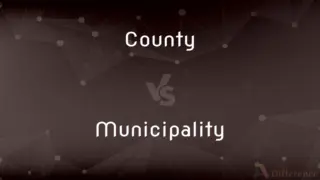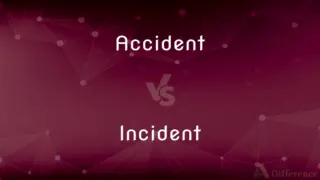Plants vs. Humans — What's the Difference?
By Fiza Rafique & Urooj Arif — Updated on May 8, 2024
Plants are autotrophic, producing their own food via photosynthesis, while humans are heterotrophic, requiring external food sources.

Difference Between Plants and Humans
Table of Contents
ADVERTISEMENT
Key Differences
Plants are primarily autotrophic, using sunlight to synthesize nutrients from carbon dioxide and water through photosynthesis. Whereas, humans are heterotrophic organisms that must consume organic compounds for energy.
Plants possess cell walls made of cellulose, which provide structural support and protection. On the other hand, humans have a skeletal structure that supports and protects their internal organs but lacks cell walls.
Plants grow continuously throughout their life due to the presence of meristematic tissue. Conversely, human growth is generally limited to certain developmental stages, primarily ceasing after adolescence.
Plants are adapted to absorb essential mineral nutrients from their surrounding environment through their root systems. In contrast, humans must ingest and metabolize nutrients from a variety of food sources.
Comparison Chart
Nutrition
Autotrophic (photosynthesis)
Heterotrophic (consume organic food)
ADVERTISEMENT
Cell Structure
Cell walls made of cellulose
No cell walls; have a bony skeleton
Growth
Continuous, via meristems
Limited mostly to early life stages
Nutrient Uptake
From soil through roots
From food through digestive system
Compare with Definitions
Plants
A pigment vital for photosynthesis.
Chlorophyll gives leaves their green color.
Humans
Reproductive cells (sperm and eggs).
Human reproduction depends on the fusion of male and female gametes.
Plants
Organisms that produce their own food from inorganic materials.
Most plants are autotrophs, using sunlight for photosynthesis.
Humans
Organisms that obtain food by consuming other life forms.
Humans are heterotrophs that require a varied diet.
Plants
Plant tissue responsible for growth and regeneration.
The grass regrows quickly due to its active meristem at the base.
Humans
Organs that process food and absorb nutrients.
The human digestive system includes the stomach and intestines.
Plants
A complex carbohydrate that constitutes the cell wall in plant cells.
Cellulose gives plant cells their rigidity and strength.
Humans
The internal framework composed of bones.
The human skeleton provides structure and protects organs.
Plants
Pores on leaf surfaces for gas exchange.
Stomata open and close to regulate CO2 intake and water release.
Humans
A developmental phase marked by growth spurts.
Human growth in height is most significant during adolescence.
Plants
Any of various photosynthetic, eukaryotic, multicellular organisms of the kingdom Plantae characteristically containing chloroplasts, having cell walls made of cellulose, producing embryos, and lacking the power of locomotion. Plants include trees, bushes, herbs, ferns, mosses, and certain green algae.
Humans
A member of the primate genus Homo, especially a member of the species Homo sapiens, distinguished from other apes by a large brain and the capacity for speech.
Plants
A plant having no permanent woody stem; an herb.
Humans
A person
The extraordinary humans who explored Antarctica.
Plants
Any of various fungi, algae, or protists that resemble plants and were formerly classified in the plant kingdom. Not in scientific use.
Humans
Of, relating to, or characteristic of humans
The course of human events.
The human race.
Plants
A building or group of buildings for the manufacture of a product; a factory
Works in an auto plant.
Humans
Having or showing those positive aspects of nature and character regarded as distinguishing humans from other animals
An act of human kindness.
Plants
The buildings, fixtures, and equipment, including machinery, tools, and instruments, necessary for an industrial operation or an institution
The university's mechanical plant.
Humans
Subject to or indicative of the weaknesses, imperfections, and fragility associated with humans
A mistake that shows he's only human.
Human frailty.
Plants
A person placed in a group of spectators to influence behavior.
Humans
Having the form of a human.
Plants
A person stationed in a given location as a spy or observer.
Humans
Made up of humans
Formed a human bridge across the ice.
Plants
A misleading piece of evidence placed so as to be discovered.
Humans
Plural of human
Plants
A remark or action in a play or narrative that becomes important later.
Humans
All of the inhabitants of the earth;
All the world loves a lover
She always used `humankind' because `mankind' seemed to slight the women
Plants
(Slang) A scheming trick; a swindle.
Plants
To place or set (seeds, for example) in the ground to grow.
Plants
To place seeds or young plants in (land); sow
Plant a field in corn.
Plants
To place (spawn or young fish) in water or an underwater bed for cultivation
Plant oysters.
Plants
To stock with spawn or fish.
Plants
To introduce (an animal) into an area.
Plants
To place or fix in a certain position
Planted both feet on the ground.
Planted a kiss on my cheek.
Plants
To deliver (a punch or blow).
Plants
To fix firmly in the mind; implant
"The right of revolution is planted in the heart of man" (Clarence Darrow).
Plants
To establish; found
Plant a colony.
Plants
To station (a person) for the purpose of functioning in secret, as by observing, spying, or influencing behavior
Detectives were planted all over the store.
Plants
To place secretly or deceptively so as to be discovered or made public
Planted a gun on the corpse to make the death look like suicide.
Plants
To conceal; hide
Planted the stolen goods in the warehouse.
Plants
Plural of plant
Common Curiosities
How do humans and plants differ in nutrient absorption?
Plants absorb nutrients mainly from soil through their roots, while humans digest and absorb nutrients from consumed food.
Why do humans need to eat food?
Humans need to eat to obtain essential nutrients that their bodies cannot synthesize.
Can plants grow indefinitely?
Many plants can grow continuously throughout their lives due to their meristematic tissues.
Why is adolescence important in humans?
Adolescence is a critical period of physical and psychological development in humans.
What is the role of cellulose in plants?
Cellulose provides structural support to plant cells, helping maintain their shape.
Are all plants green?
Most plants are green due to chlorophyll, which is crucial for photosynthesis, though some may have different colored parts.
How do plants use their stomata?
Plants use stomata to manage gas exchange, crucial for photosynthesis and respiration.
What is photosynthesis?
Photosynthesis is the process by which plants convert light energy into chemical energy, storing it in carbohydrates.
What does the human skeletal system do?
The human skeletal system provides structural support and protects vital organs.
How do human gametes function?
Human gametes are involved in reproduction, where sperm and egg merge to form a zygote.
Share Your Discovery

Previous Comparison
County vs. Municipality
Next Comparison
Accident vs. IncidentAuthor Spotlight
Written by
Fiza RafiqueFiza Rafique is a skilled content writer at AskDifference.com, where she meticulously refines and enhances written pieces. Drawing from her vast editorial expertise, Fiza ensures clarity, accuracy, and precision in every article. Passionate about language, she continually seeks to elevate the quality of content for readers worldwide.
Co-written by
Urooj ArifUrooj is a skilled content writer at Ask Difference, known for her exceptional ability to simplify complex topics into engaging and informative content. With a passion for research and a flair for clear, concise writing, she consistently delivers articles that resonate with our diverse audience.
















































